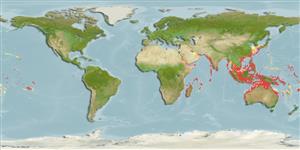Common names from other countries
Environment: milieu / climate zone / depth range / distribution range
Ecologie
; brakwater; diepteverspreiding 0 - 80 m (Ref. 125642). Tropical; 36°N - 31°S, 30°E - 135°W
Indo-Pacific. From East Africa to French Polynesia, north to Japan and south to Australia. Tropical to temperate.
Length at first maturity / Size / Gewicht / Leeftijd
Maturity: Lm 8.3, range 8 - ? cm Max length : 20.0 cm CW mannelijk/geslacht niet bekend; (Ref. 343); 21.5 cm CW (female); Maximaal vermelde leeftijd: 3.00 jaren (Ref. 128174)
Carapace finely granulose, regions just discernible; 9 teeth on each anterolateral margin, the last tooth 2 to 3 times larger than preceding teeth. Chelae elongated in males; larger chela with conical tooth at base of fingers; pollex ridged. Color: olive to dark green, with 3 prominent maroon to red spots on posterior 1/3 of carapace. Easily distinguished from other species by its very distinct color markings.
Maximum length (female) from Ref. 119750. Occurs from the intertidal zone (especially juveniles) to depths of 30 m (Ref. 343). Subtidal (Ref. 106854). Inhabits sandy to sandy-muddy substrates (Refs. 343, 106287, 125338), in bays and estuaries (Ref. 106287). Also in brackish water (Ref. 801). Subtropical and tropical climates (Ref. 343). Mainly a predator of sessile and slow-moving benthic macroinvertebrates (Ref. 102720); may be a scavenger (Ref. 100855). Omnivore (Ref. 116259).
Members of the order Decapoda are mostly gonochoric. Mating behavior: Precopulatory courtship ritual is common (through olfactory and tactile cues); usually indirect sperm transfer.
Ng, P.K.L. 1998. (Ref. 343)
Status op de Rode Lijst van het IUCN (Ref. 130435)
Status bij CITES (Ref. 108899)
Not Evaluated
Not Evaluated
Gebruik door de mens
Visserij: commercieel
| FishSource | Sea Around Us
Tools
Internet-bronnen
Estimates based on models
Preferred temperature
(Ref.
115969): 18.3 - 29, mean 27.5 (based on 1552 cells).
Weerstandsvermogen
Hoog, minimale populatieverdubbelingstijd minder dan 15 maanden (K=0.82-1.9; tm=0.65; tmax=3).
Kwetsbaarheid
Low vulnerability (10 of 100).
